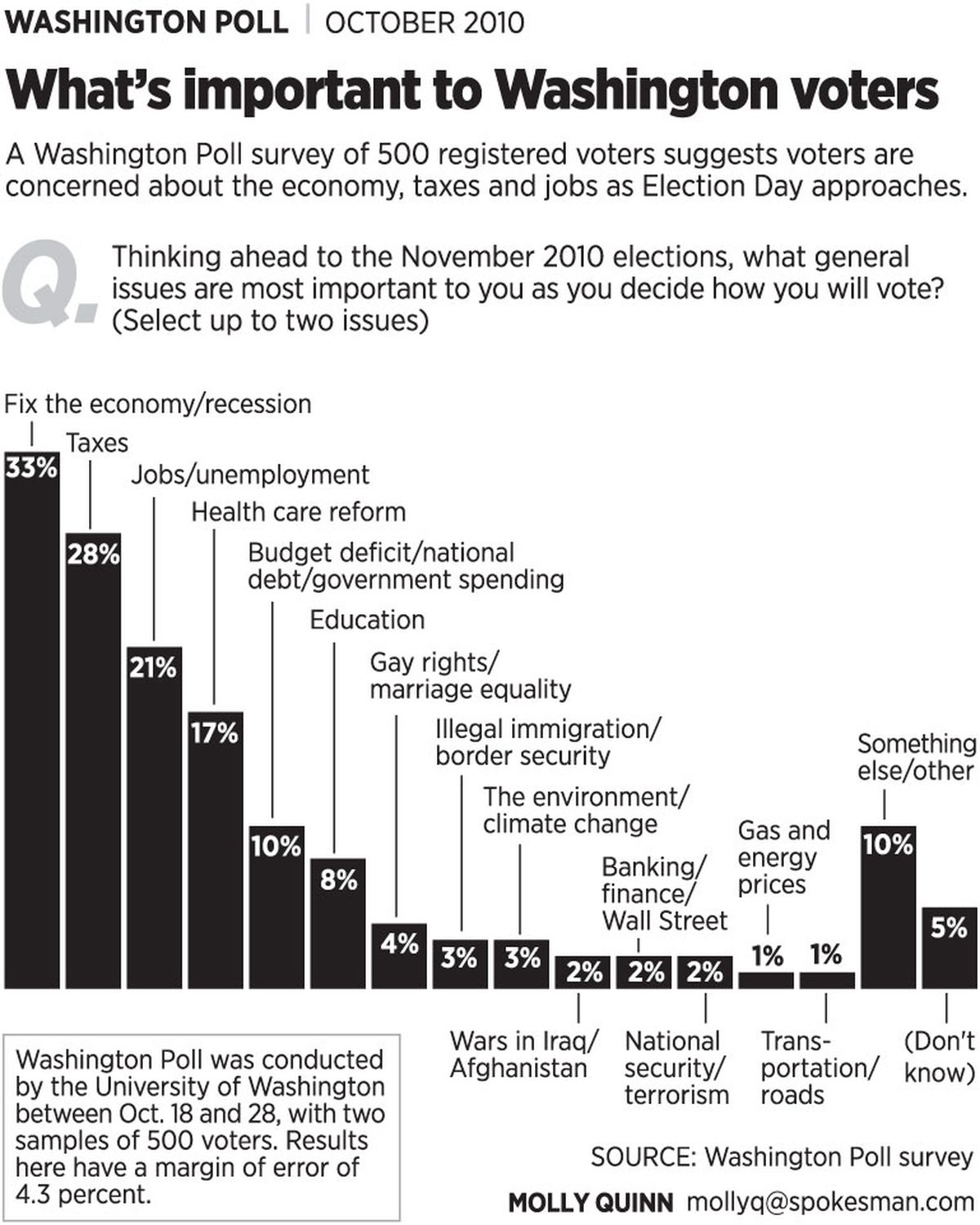Washington voters seeking new path
Poll finds hefty percentage think state headed in wrong direction

Washington voters stagger to Tuesday’s election bombarded by television commercials designed to convince them their incumbent senator is a spendthrift changeling and her would-be replacement is a sleazy grifter.
The other people featured on the ballot aren’t any better, voters have been told, although not quite as often or with ads quite so slick.
Voters are urged to strike back at politicians who can’t be trusted with decisions on taxes or the control over their booze. At the same time, they’re warned about falling for the siren songs of big-moneyed interests and leaving their local governments in the lurch.
They’ll need to pick the best system for helping workers who get injured on the job, decide whether more criminal suspects should be kept in jail before trial and whether the state’s debt limit is properly calculated.
It would be a lot to consider in the best of times. But as the election approaches, Washington voters likely aren’t thinking these are the best of times.
When recently asked their opinion of the direction of the state, 47 percent of voters surveyed for the Washington Poll said the state was “seriously on the wrong track,” while only 37 percent said it was headed in the right direction.
That’s the most negative voters have been since the poll started asking the question in 2006, professor Matt Barreto of the University of Washington said. Usually, those who say the state’s headed in the right direction have the greatest showing.
But given the campaigns, and the issues candidates are stressing such as the sluggish economy, the deficit and taxes – as well as the news media’s coverage of the races – the real surprise may be that the “wrong track” numbers aren’t higher, Barreto said.
“Almost all the coverage is of voters who are fed up, not going to take it anymore,” he said, so one might expect to see almost all voters answering “wrong track.” He analyzes the results as serious, but not dire in Washington: “It’s not a ‘sky is falling’ situation. It’s a course correction.”
Voters were equally divided between whether they support or oppose federal health care reform and what’s known as Wall Street reform, and whether they approve or disapprove of the tea party movement. They strongly approve of requiring the Legislature to pass tax increases with a two-thirds majority, and of the military dumping its “don’t ask, don’t tell” policy. They slightly favor, 45 percent to 40 percent, extending the Bush tax cuts, but that support jumps to 58 percent to 25 percent when asked if they should be extended only to those making less than $200,000 a year.
For all the discussion of the tea party movement nationally, there’s not much sign it will be a deciding factor Tuesday, Barretto said. Those who strongly approve of the tea party may actually be a bit less likely to cast a midterm ballot than those who strongly disapprove, he said. The “enthusiasm gap” for Democrats may exist in other states, but doesn’t seem to be a factor in Washington.
Fixing the economy tops the list of issues voters say are important to them, followed by taxes, jobs, health care and the deficit. They are more likely to blame former President George W. Bush than President Barack Obama for the state of the economy; asked to choose, 57 percent said Bush was at fault, and 33 percent said Obama. Barretto said most voters are probably figuring Obama inherited most of the problems, but “if nothing changes by 2012, they’re going to blame him.”
They have a generally low opinion of Congress and the Legislature, and are evenly split over whether they’d be better off with Democrats or Republicans in charge in Olympia.
Oh, and that U.S. Senate race? It was close, although not quite as close as two other polls released late last week. Rasmussen Research had Republican Dino Rossi ahead by 1 percentage point, Survey USA had Rossi and incumbent Democrat Patty Murray tied at 47 percent each. The Washington Poll has Murray leading 49 percent to 45 percent among all voters surveyed and 51 percent to 45 percent among likely voters. But even that’s within the poll’s margin of error.
But only the voters themselves know if they’re likely to cast a ballot. Elections officials estimate about two out of five voters have already cast ballots. The rest have until 8 p.m. Tuesday to decide if and how they want to vote.